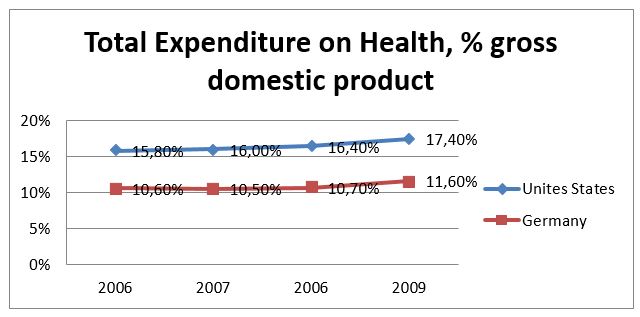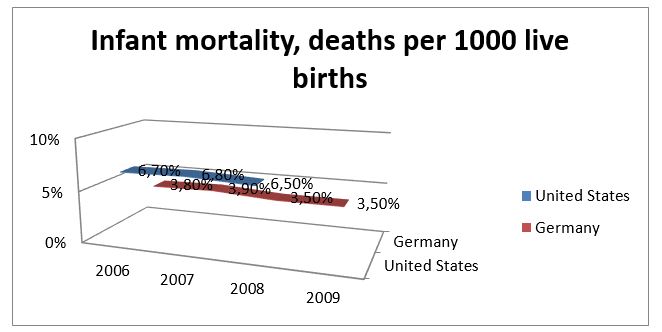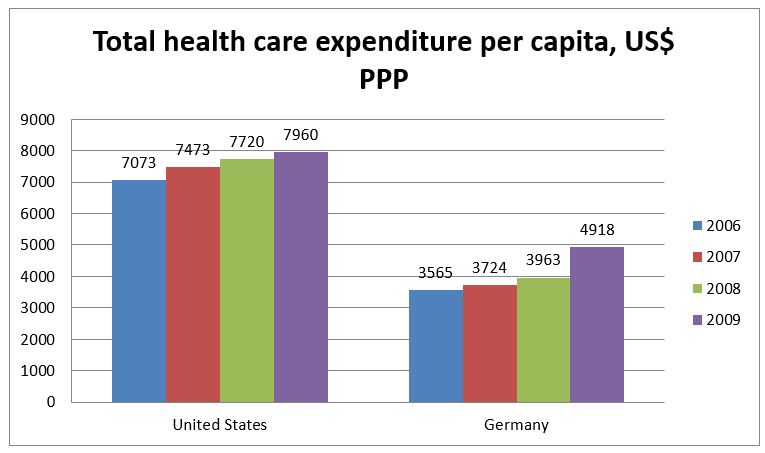Health Insurance in Germany, Research Paper Example
An Economic Analysis of Health Insurance in Germany: Lessons for the United States
Introduction
The United States may learn from health insurance systems of other countries. The U.S. health care system still receives criticisms. About 49.9 million American citizens still do not have health insurance (US Census Bureau). In such a situation, the system is not working well. Scholars suggest that the American government can take lessons from foreign health care systems to improve U.S. health insurance. Joseph Newhouse (1993) discusses the importance of a health insurance system to policy and public finance in his book, Free for All. Newhouse and his colleagues conducted an experiment to determine what will happen to health when people pay a high price for health services. Their findings suggest that people will deny themselves healthcare services because of the steep price they should pay. In addition, there are also studies that show the crucial role of health care insurance in decreasing the risk of high medical expenditures that people have to pay for themselves. The level of economic well-being of Americans disintegrates when the government ignores the value of health care insurance (Burkhauser and Simon). This paper explores what U.S. can learn from the German health insurance system.
Background of the Study
Scholars assert that providing all American with health insurance is the first step towards developing an ideal health care system. After the implementation of universal coverage, competition happens in terms of quality, costs, and other things. Germany’s health insurance system can strategically foster competition among players in the insurance industry. It is necessary to understand how the German health insurance system works before proceeding to the main analysis.
The “Bismarck model” is the model Germany’s health insurance system follows. Self-governing corporatist bodies and income-related contributions manage the health care system. This is the core element of the Bismarck model. Thomas Gerlinger and Rolf Schmucker (2010) point out that the dynamic processes that occurred since 1990s within the health care system affected the Bismarck model. These processes impact the health insurance system because the core elements of the Bismarck model lose an immense deal of their importance. Other studies suggest that no fundamental changes happened since the Bismarck implemented the model in the 19th century. Note that the health insurance system in Germany in compulsory. The reason for the successful implementation is a decentralized decision-making process. Another reason is the development of an effective negotiation system between providers and third-party players.
Scope and Delimitation
This study will only discuss and compare the health insurance system of Germany and U.S. in relation to public finance. This paper has no intention to delve deeper into the ethical side of the health insurance system discussion.
Objective
This paper has two main objectives:
- To conduct an economic analysis on the health insurance of Germany
- Todetermine lessons U.S. can derive from German health insurance
The discussion starts with the relation of public financing and health care insurance. It will then proceed to discussing how U.S. and Germany funds their respective systems. The paper will compare and contrast the German and American system.
Discussion and Analysis
Public Financing and Health Insurance System
Policy makers in general agree that health care system should be able to provide universal insurance. However, no one can also deny that this might drain the national resources. In addition, it is difficult to sustain. At the same time, governments are thoroughly aware that the health care system is not a concern to be left entirely to the business sector. Hence, most countries adopt a private-public mix to fund their health care system. People traditionally ask who pays for their health insurance. Today, the question shifts to determining an effective formula for cost sharing. Seeking such formula takes into consideration the need to balance efficiency goal with equity concerns (Lim).
There are those who advocate for increased private spending on health insurance. There are also those who are for increased public spending. On the one hand, advocates of increased private spending on healthcare within a mixed system highlight its role as a safety valve. This safety valve relieves pressure on the public purse. On the other hand, advocates of increased publics pending claim that it best meets social objectives such as equity of access (Shiell and Seymour). The next section discusses the roles of public and private sectors in the health insurance system of U.S. and Germany.
Differences between Health Insurance System of U.S. and Germany
Most people in the U.S. avail their health insurance from private insurance firms because they cannot rely on public programs. The U.S. system has a set of certain eligibility requirements that the elderly, low-income children and families must meet to avail public programs. There are two primary public programs. These are the Medicare and Medicaid. The cost of health care is increasing more and more over the years. As a result, funding health public programs has become a burden for the national resource. The percentage of people covered by government insurance is 31% in 2010. That is about 95 million people. The rate of people covered by private insurance is 64% in 2010 (US Census Bureau).
Most people in German rely on the government for their health insurance; unlike in the U.S. various sources pay the health insurance of German citizens. There are two main types of health insurance. These are accident insurance and long-term care. Furthermore, there are two main, separate types of health insurance. These are public health insurance and private insurance. The rate of people covered by government insurance is 90% of the population. Private insurance companies cover the remaining 10% (Grunow and Nuscheler).
There are differences between the German and U.S. health insurance system. In U.S., the health insurance system is problematic. Employers mostly provide insurance to their employees. Note, however, that the government does not mandate all employers to do this. The coverage of such insurance is also remarkably limited. Also, a person has the responsibility to pay for the full insurance premium in case of losing the job. All coverages will be lost at once if the person fails to do so. Insurance companies have the freedom to deny service to people who already have certain diseases. The result is an increasing medical expenditure especially among the low-income. This sometimes results to medical bankruptcy. On the other hand, everybody is Germany has health insurance. Employers were the ones who pay half of the insurance premium of their employees. This is a fixed percentage of the salary. This means that people with high income will subsidize the low-income. It is the government who pays for the insurance premium of the unemployed citizens. Statistics show that, in terms of public finance, Germany perform better than the United States. The chart below demonstrates this:

Source: http://stats.oecd.org/Index.aspx?DataSetCode=HEALTH_STAT
In addition to this, U.S. fares worse in infant mortality compared to Germany. The chart below demonstrates this.

Source: http://stats.oecd.org/Index.aspx?DataSetCode=SHA
Note that the life expectancy between U.S. and Germany are roughly the same. However, as the graph below shows, the total per capita health care expenditure is higher in the U.S. compared to Germany.

What U.S. Can Learn from Germany’s Health Insurance System
U.S. system can learn from the successes and the failures of German insurance systems (Castaneda). The principle of solidarity is the fundamental aspect of Germany’s health insurance system. Traditional principles of decentralization and self-regulation are crucial to his system. However, certain socio-economic groups have the freedom not to take part in the system (Pütz and Hagist). Tehniker Krankenkasse, Germany’s third largest statutory health insurance funds, implemented a pilot scheme that involved the utilization of deductibles. This is to tell whether rates that incorporate deductibles are compatible with the principles of social solidarity. Promoting the appeal of statutory health insurance funds compared with other health insurance companies is another reason. There are three main results from these deductibles. These are the deductibles’ compatibility with the principles of solidarity; deductibles can provide an effective means of defection to private health insurance companies; and the deductibles can reduce the volume of insurance claims (Pütz and Hagist).
The U.S. system can learn from the German system in terms of how the latter fosters competition. In Germany, private insurance companies compete directly for members with the national health insurance programs. According to Karl Lauterbach, health economist and member of the German parliament, the government can foster competition that is suitable for health insurance system (PBC). This is also beneficial for low-income citizens who can barely afford access to medical services. The German health care system combines competition sickness funds and a universal coverage plan. This is a unique feature of the German health care system.
The American health care system may have both private insurance and competition. However, such system does not allow everyone to avail insurance that covers everything. Germany was able to make it possible that everyone can be covered with everything and manage to foster competition. Note the competition within the sickness fund does not aim primarily to profit. In fact, the German government does not permit sickness fund to profit. The main idea, Lauterbach maintains, is to provide enough room for an incentive for competition. The opportunity to excel also lures the sickness fund members to take part. This is because of the ranking contribution rate where businesses can advertise. They can advertise through offering cheap sickness funds and superior quality. Moreover, the German system works quite the same as the U.S. system does with its Medicare program. They are the same in terms of setting fixed reimbursement rates for hospitals. However, the German system extracts price concession from drug firms.
Private insurance firms rarely compete with public programs directly. Germany managed to do this. As mentioned, the government requires everyone to have health insurance. They have the freedom to choose whether to avail it from public or private insurance programs. Private insurance is more expensive than pubic insurance programs. In addition, provider fees and administrative costs are also higher than public programs. Naturally, most people will go for public programs. Private insurance firms compete on the ground of risk selection. This is something that regulation cannot entirely eliminate. The citizens have wide range of selection when it comes to choosing which program to avail.
Conclusion
Providing all American with health insurance is the first step towards developing an ideal health care system. U.S. can learn from the German health insurance system. As mentioned above, it is no longer a question of “Who must pay for the health insurance of the citizens?” The cost of medical care is increasing more and more over the years. This will surely become a burden to the national resource especially in times of economic turmoil. The question is on what the optimal formula is. The goal of such a formula is to strike a balance between efficiency goals and equity concerns in an attempt for a fair cost-sharing. On the one hand, most people in the U.S. avail their health insurance from private insurance firms because they cannot rely on public programs. On the other hand, most people in German rely on the government for their health insurance.
U.S. can learn from the principle of solidarity that the German system adopts. Note that the U.S. insurance system does not allow everyone to avail insurance that covers everything. This is the case even if both private and public programs are available. In terms of cost-sharing, America should foster a competition that targets profit accumulation as one of its priorities. In other words, America should learn maximizing competition and minimizing profit. America can learn something about the principle of solidarity. This principle maintains that one should pay for one’s insurance based on one’s ability to pay. However, this principle also maintains that appropriate health care should be provided to everyone. Financing and risk-pooling systems make the principle of solidarity works. In this system, a national, government-regulated central fund collects the health insurance premium. The government then redistributes the collected fund to independent, nongovernmental sickness funds. It is among these funds that the Germans can freely choose. Such system requires tight regulatory processes for it to work.
In the final analysis, one cannot take out the role of the private sector when one wished to understand the role of public financing in health insurance system. This is due to the kind of market system that shapes the global economy. In the face of an ever increasing cost of health care services, it is truly difficult for the national resource to shoulder the entire burden. The least it can do is to develop regulatory processes that can make health care for anyone at roughly equal terms. This is by maximizing competition and minimizing profit. It is through this kind of cost-sharing that Germany can provide health insurance to all. Maybe it is time for America to learn from the principle of social solidarity from that side of the world.
References
Burkhauser, Richard and Kosali Simon. “Measuring the Impact of Health Insurance on Levels and Trends in Inequality.” 2012.
Castaneda, Heidi. “Health Insurance System and Reform in Germany.” Society for Medical Anthropology. 21 March 2012 <http://www.medanthro.net/research/cagh/insurancestatements/Castaneda%20(Germany).pdf>.
Gerlinger, Thomas and Rolf Schmucker. “A Long Farewell to the Bismarck System: Incremental Change in the German Health Insurance System.” German Policy Studies 6.3 (2010): 3-20,169.
Grunow, Martina and Robert Nuscheler. “Public and Private Health Insurance in Germany: The Ignored Risk Selection Problems.” 2010.
Lim, Meng-Kin. “Shifting the burden of health care ?nance: a case study of public–private partnership in Singapore.” Health Policy 69 (2004): 83–92.
Newhouse, Joseph. Free for All? Cambridge, MA: Harvard University Press, 1993.
OECD. “OECD Health Statistics.” 2011. OECD Datbase. 21 March 2012 <http://stats.oecd.org/Index.aspx?DataSetCode=HEALTH_STAT>.
PBC. “Interview: Karl Lauterbach.” 15 April 2008. Public Broadcasting Service Website. 21 March 2012 <http://www.pbs.org/wgbh/pages/frontline/sickaroundtheworld/interviews/lauterbach.html>.
Pütz, Claudia and Christian Hagist. “Optional Deductibles in Social Health Insurance Systems.” The European Journal of Health Economics : HEPAC 7.4 (2006): 225-30.
Shiell, Alan and Jannel Seymour. “Preferences for public health insurance: Egotism or altruism?” International Journal of Social Economics 29.5 (2002): 356-369.
US Census Bureau. “Health Insurance Highlights 2010.” 2010. U.S. Census Bureau. 22 March 2012 <http://www.census.gov/hhes/www/hlthins/data/incpovhlth/2010/highlights.html>.
—. “Number Uninsured and Uninsured Rate: 1987 to 2010.” 2010 http://www.census.gov/hhes/www/hlthins/data/incpovhlth/2010/fig07.pdf. U.S. Census Bureau. 21 March 2012 <http://www.census.gov/hhes/www/hlthins/data/incpovhlth/2010/fig07.pdf>.

Time is precious
don’t waste it!

Plagiarism-free
guarantee

Privacy
guarantee

Secure
checkout

Money back
guarantee






